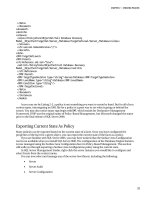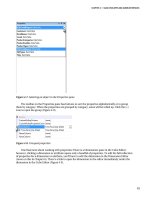Apress - Pro SQL Server 2008 Analytics_ Delivering Sales and Marketing Dashboards (2009)02
Bạn đang xem bản rút gọn của tài liệu. Xem và tải ngay bản đầy đủ của tài liệu tại đây (934.87 KB, 10 trang )
23
■ ■ ■
CHAPTER 2
Seven Keys to Successful
Reporting Projects
F
inding the balance between the functional components of an analytics implementation, like
process design, key performance indicator (KPI) development, development, look and feel,
and the technical items, like tool selection and complex feature development, is a daunting task.
You typically must evaluate the trade-offs associated with spending time in one area vs. another.
This chapter will focus on providing you with the key tasks and tools necessary to lay an effec-
tive groundwork for any analytics implementation, large or small.
The Seven Keys Approach
Our approach to BI is based on three fundamental beliefs:
• All successful BI projects start with an understanding of the key metrics that drive the
business and work through a proven design and implementation approach.
• Cost-effective BI projects focus on leveraging only the components of the BI platform
necessary to deliver the key metrics in an accurate and timely manner. There is no one-
size-fits-all solution when selecting the right components of the BI platform. A large part
of defining the technical solution has to be driven by selecting the right tool for the skill
level and preferences of the user community.
• Integrity of the business processes and underlying data will ultimately define the success
or failure of any created reports, dashboards, and scorecards.
With these beliefs in mind, we recognize that successful business intelligence initiatives
will require different tools from the Microsoft BI platform for different organizations, but we
use a set of seven common key tasks that allow our clients to select the right technologies and
to make the appropriate implementation choices to achieve their desired outcomes.
Key 1: Developing Executive Sponsorship
The first key of a successful business intelligence project begins at the top. Ensuring that the
management team and key managers are aligned with the goals of the project will allow these
individuals to take a more active role in designing and implementing an analytics solution.
This executive sponsorship can take two forms: department managers and senior executives.
Paulen_19286 .book Page 23 Monday, April 27, 2009 5:02 PM
24
CHAPTER 2
■
SEVEN KEYS TO SUCCESSFUL REPORTING PROJECTS
Department Managers
As we mention briefly in Chapter 1, a number of factors contribute to failed business intelli-
gence initiatives, including a lack of trust. Oftentimes, when senior executives use analytics to
quantify the success or failure of a specific group or department, managers will immediately
dismiss the quality of the data or will challenge the availability of the displayed information. In
addition to posing an employee-management challenge, this lack of trust creates other issues
throughout the team.
Paramount among the additional issues created is proliferation of distrust throughout the
rest of the employees in the business unit. Once managers distrust the analytics presented to
them, members of their teams will not only follow suit but may begin to use critical business
applications less frequently.
Senior Executives
From a senior executive perspective, there are two distinct values to having a great reporting
solution. First, it is important to have metrics to point to when gauging the health of a business.
Second, analytical information is invaluable when managing employees and providing feed-
back during evaluations.
To ensure adoption of the delivered solution, senior executives can choose between the
carrot and the stick approaches. While both of these approaches have merit, the decision on
direction depends on management style and the existing adoption situation within an organi-
zation. Based on our experience, few managers have the stomach to make the stick work in the
absence of carrots, so keep that in mind as your planning process progresses.
Regardless of their positions in the organization, the executive sponsors’ roles in the
process are to drive requirements, facilitate the key performance indicator and deliverable
prioritization process, and drive the overall process to completion. Ultimately, the sponsor
should ensure that the organization seeks outside help where needed but owns the overall
implementation.
Key 2: Identifying Organizational Key
Performance Indicators
The second key step to effectively leverage the Microsoft BI tools is to identify the key organiza-
tional metrics that drive business performance; such metrics are called key performance
indicators (KPIs). This may sound obvious, but it’s critical to have a clear business-oriented
target when selecting the appropriate components of the platform to use. In addition, it’s
important to not only identify the metrics that stakeholders find interesting but to focus on
identifying and clearly defining the metrics that serve as leading indicators for where the business
is headed for each key stakeholder group.
This process can be as simple as creating a list of the important metrics and may result in
the identification of 10 to 20 key metrics for each stakeholder group and 10 to 20 key metrics for
the executive team and board. Once the list is generated, each metric can be evaluated against
a number of criteria, including these:
Paulen_19286 .book Page 24 Monday, April 27, 2009 5:02 PM
CHAPTER 2
■
SEVEN KEYS TO SUCCESSFUL REPORTING PROJECTS
25
• Is the data that it takes to evaluate this KPI trustworthy and readily available?
• Is the metric well defined, and will it make sense to those who evaluate it?
• Does the identified metric align with the goals of the organization?
Figure 2-1 provides a high-level example of what makes a good metric. Significantly more
information on developing KPIs can be found in Chapter 3.
Figure 2-1. Ideal KPIs
Key 3: Delivering Structured, Ad Hoc Reports
Once you have secured executive sponsorship and reviewed and developed the KPIs that are
pertinent to the business, it is appropriate to move into the evaluation and solution design
process. Keep in mind that, in phase one at least, you should deliver only the most necessary
solution components. Your solution and evaluation process should include selecting the appro-
priate technologies, reviewing the appropriate Microsoft BI tools for various user roles, and
identifying and prioritizing final phase-one solution components.
Selecting Appropriate Technologies
Evaluating the technologies to use for phase one of the implementation is an important process.
This evaluation should include the high-level decision points and questions described in the
following subsections.
Assessing Existing Technology Investments
Take stock of the organizations’ existing BI tools. Understanding what is available will allow
better-informed decisions to be made, in terms of both additional product purchases and
investments in consulting assistance during the analytics implementation. Here are some
questions to consider:
Paulen_19286 .book Page 25 Monday, April 27, 2009 5:02 PM
26
CHAPTER 2
■
SEVEN KEYS TO SUCCESSFUL REPORTING PROJECTS
• What technologies does my organization currently own?
• Do I need to purchase additional technologies?
• If so, what is the associated cost?
Leveraging products that are already part of the organization, and thereby reducing the
phase-one investment, may also enable the business to be more patient when evaluating the
results of the initial implementation. Based on our experience, many organizations rush to
judgment when the results are not immediately clear.
Taking time and having the patience to allow the results to morph during the months
immediately following the implementation will benefit the organization. While data-availability
and quality issues may arise, if the initial investment is manageable, both time and funds
(if needed) will then be available to make these adjustments.
Assessing Technology Complexity
Think about the complexity of the available solutions. Some questions to consider follow:
• Do Excel pivot tables and graphs achieve my goals?
• Can I develop and understand my KPIs using SQL Server Reporting Services (SSRS)?
• How should the reports and dashboards I develop be made available to users?
Assessing Power User and I.T. Skill Sets
One reason to think about the complexity of the solutions you might implement is that, ultimately,
people have to use and apply those solutions. A sure road to failure is to pick a solution that is
too complex for the users in question. So consider these questions:
• Do I have data or reporting analysts as part of the business units consuming the reports?
• With what technologies are my IT and development staff members comfortable working?
Leveraging functional expertise as needed is important. However, you should ultimately
own your analytics implementation. This notion of ownership is also true when it comes to
building and supporting the tools developed. Like most business applications, if reports aren’t
consistently tweaked and updated, the information they present will become stale and hold
less value for the organization. Table 3-1 provides a high-level overview of the development
and administration capabilities needed to work with many of the available Microsoft tools.
At every stage in the functional deployment process, these technology items should be
considered. Working through these items makes straightforward tasks of evaluating the Microsoft
BI platform and targeting the appropriate tools to get business users on their way to making
better-informed decisions aligned with their KPIs.
Paulen_19286 .book Page 26 Monday, April 27, 2009 5:02 PM
CHAPTER 2
■
SEVEN KEYS TO SUCCESSFUL REPORTING PROJECTS
27
Reviewing the Appropriate Microsoft BI Tools for Various
User Roles
From a technology perspective, evaluating tools relative to those needing to use them is likely
the most important factor in selecting which components belong in phase one. Specifically,
when provided with tools that don’t meet their daily or reporting needs, business users may
begin to utilize data and tools that are not part of the organization-wide strategy for business
intelligence.
The following roles should be considered when reviewing the appropriateness of users’ tools:
• Reporting and data analysts: Employees who are responsible for generating reports and
evaluating the success of KPIs developed for the business
• Business application users: Users like sales or service representatives who are the source
of much of the organization’s valuable data and who spend most of their time within
lines of business applications or Microsoft Outlook
• Senior executives and managers: Individuals within the organization who need to see
quick, often graphical representations of information and statistics
Reports available for analysts, such as the example in Figure 2-2, typically offer options
allowing analysts to see both the data and associated graphical representations. Additionally,
those reports often offer tools that analysts can use to slice, dice, and filter the data as needed
to accomplish the desired results and answer the analyst’s questions. Finally, many analyst-
focused reports and dashboards emphasize the way in which data is trending.
Table 3-1. Microsoft Product Development Skills
Microsoft Product Development Skills and Environment Data Access
Excel Business users can develop reports
through knowledge of pivot tables
and Excel functions.
Users will have built-in access to
online analytical processing (OLAP)
cubes and SQL Server data.
Access is most frequently accom-
plished through pivot tables.
SQL Server Reporting
Services (SSRS)
Reports are developed via the
Microsoft BI Studio (Visual Studio)
using SQL and Multidimensional
Expressions (MDX).
SSRS provides built-in access to
OLAP cubes and authoring for SQL
Server data sets.
SQL Server Analysis
Services (SSAS)
Cubes are developed via the
Microsoft BI studio (Visual Studio)
using MDX.
Cubes can consume SQL queries or
access SQL tables directly.
Paulen_19286 .book Page 27 Monday, April 27, 2009 5:02 PM









